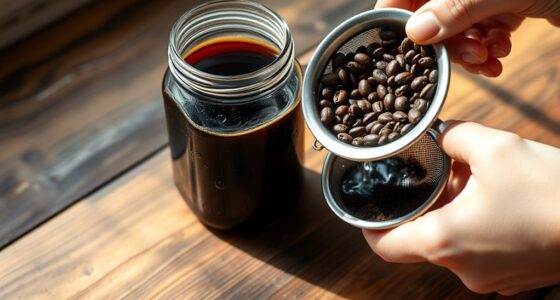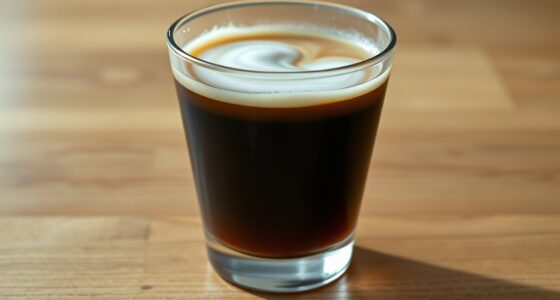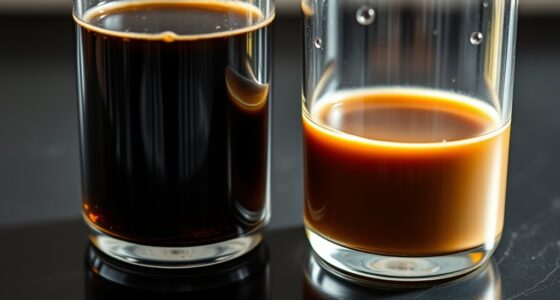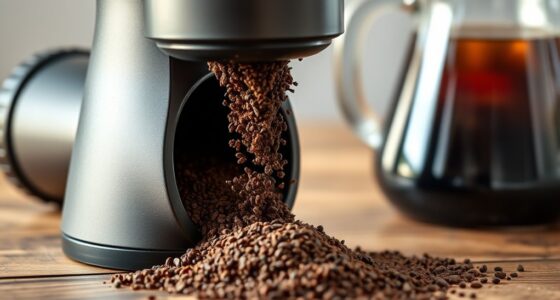If your cold brew is bitter, sour, or weak, adjusting your grind size, steep time, or sweetness can help balance flavors. For bitterness, try coarser grind and shorter steeping, while sourness often needs a longer brew and slightly finer grind. Adding sweeteners or milk softens harsh or bitter tastes. Making small tweaks to these variables can make a big difference; you’ll find more tips below to perfect your brew.
Key Takeaways
- Adjust grind size to coarse (sea salt-like) to prevent over- or under-extraction.
- Extend steep time for sour brews or reduce it to avoid bitterness.
- Add small amounts of sweetener or milk to balance excessive bitterness.
- Use fresh, high-quality beans and ensure proper storage for optimal flavor.
- Experiment with steep duration and bean grind to find the right balance for your beans.
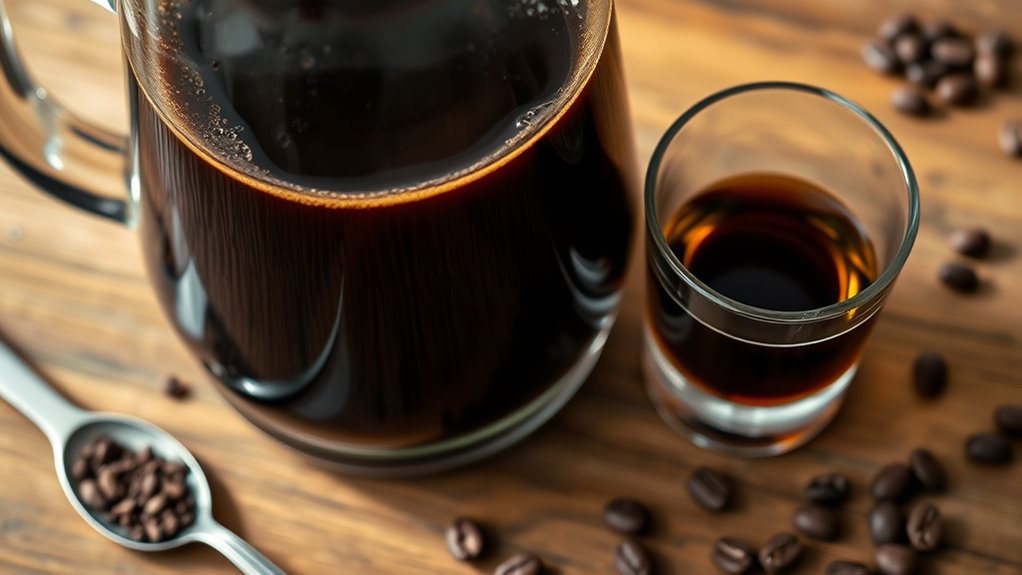
Have you ever made cold brew only to find it too weak, too bitter, or just not quite right? If so, you’re not alone. Cold brew can be tricky to perfect, and small adjustments often make a big difference. One common issue is the sweetness balance. If your cold brew tastes overly bitter or harsh, it might be because you’re not balancing the natural bitterness with enough sweetness. Adding a touch of simple syrup or a splash of milk can soften the flavor and create a more harmonious profile. Conversely, if your brew is too sour or sharp, it could mean the beans need a longer steep time or a different grind consistency. A grind that’s too coarse might result in under-extraction, leading to a sour taste, while a grind that’s too fine can over-extract, making the brew bitter.
Getting the grind consistency right is essential because it directly influences extraction. When the grind is too coarse, water flows through too quickly, leaving behind underdeveloped flavors that taste weak or sour. On the other hand, a very fine grind increases resistance, prolonging extraction and often resulting in a bitter, overly strong brew. To troubleshoot this, experiment with your grind size—aim for a consistency similar to coarse sea salt. This allows water to extract flavors evenly without overdoing it. Also, consider the brewing time. Typically, 12 to 24 hours is ideal, but if your brew is too sour or weak, adjusting the steep time can help. Longer steeping generally yields a richer, more balanced flavor, but be careful not to overdo it, or you’ll risk bitterness or muddiness.
Temperature and bean quality also play roles. Cold water extraction is gentle, but if your beans are stale or of poor quality, your cold brew won’t reach its full potential. Fresh, high-quality beans with a medium roast usually produce the best results. Additionally, understanding the automation involved in brewing can help optimize your process, ensuring consistent results every time. If you find your cold brew too bitter despite these adjustments, it could also be due to over-extraction caused by overly fine grind or too long a steep. Conversely, if it’s too weak or sour, you might need a finer grind or a longer steep. Remember, small tweaks can make a significant difference—test different variables one at a time to pinpoint what works best for your taste preferences. With patience and experimentation, you’ll be able to troubleshoot common cold brew issues and enjoy a smooth, balanced cup every time.
Frequently Asked Questions
Can I Use Regular Coffee Grounds for Cold Brew?
Yes, you can use regular coffee grounds for cold brew, but it’s best to choose a coarser grind size to prevent over-extraction and a gritty texture. Use a brewing vessel like a French press or a jar with a filter to make cleanup easier. Fine grounds can clog filters or create a bitter taste, so opt for a coarser grind for smoother, balanced cold brew.
How Does Water Temperature Affect Cold Brew Flavor?
Your cold brew’s flavor hinges on water temperature, which is like a maestro conducting a symphony. If you use water that’s too hot or too cold, it can dramatically alter flavor extraction, making your brew bitter, sour, or weak. Ideal water temperature (around room temp) guarantees maximum extraction, balancing smoothness and richness. Keep water at the right temperature to reveal the full depth and complexity of your cold brew.
Is It Okay to Reuse Cold Brew Coffee Grounds?
You can reuse cold brew coffee grounds, but it may affect the flavor and cold brew efficiency. Reusing grounds often results in a weaker, less flavorful brew since the extraction diminishes with each use. If you want a stronger taste, stick to fresh grounds for each batch. However, reusing grounds can be an eco-friendly option if you’re okay with a milder flavor and want to get the most out of your coffee.
What’s the Best Storage Method for Cold Brew?
Store your cold brew securely in a sealed, airtight container to maintain maximum flavor and freshness. Use a clean, durable brewing container for pouring, then transfer the brew to an airtight jar or bottle, safeguarding against spoilage. Keep it cool in the refrigerator to preserve flavor, prevent spoilage, and keep your brew fresh. Proper storage prevents flavor fade, fuss, and fermentation, ensuring every sip stays satisfying and smooth.
How Do I Dilute Overly Strong Cold Brew?
To dilute overly strong cold brew, you can use simple dilution techniques like adding cold water or milk until you reach your desired flavor adjustment. Start by adding small amounts, about 1:1 ratio, then taste and adjust as needed. This method helps balance the brew’s strength without sacrificing flavor, making it more enjoyable. Remember, gradual dilution makes sure you don’t over-weakening your cold brew.
Conclusion
If your cold brew’s bitterness, sourness, or weakness persists, don’t fret—think of it as a modern-day alchemist seeking perfect balance. Adjust your grind size, brew time, or coffee-to-water ratio like a seasoned wizard refining a potion. Remember, even the great explorers faced setbacks before discovering new lands. With patience and a bit of trial and error, you’ll craft a cold brew that’s just right—no need to call the 18th-century chemist, just your keen palate.


